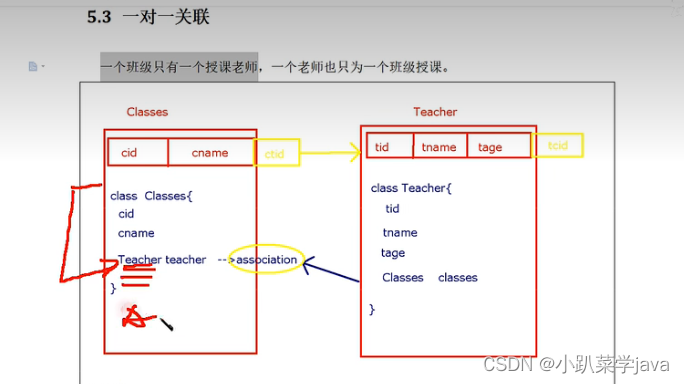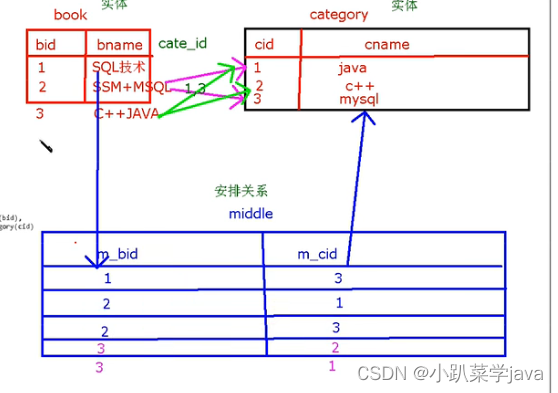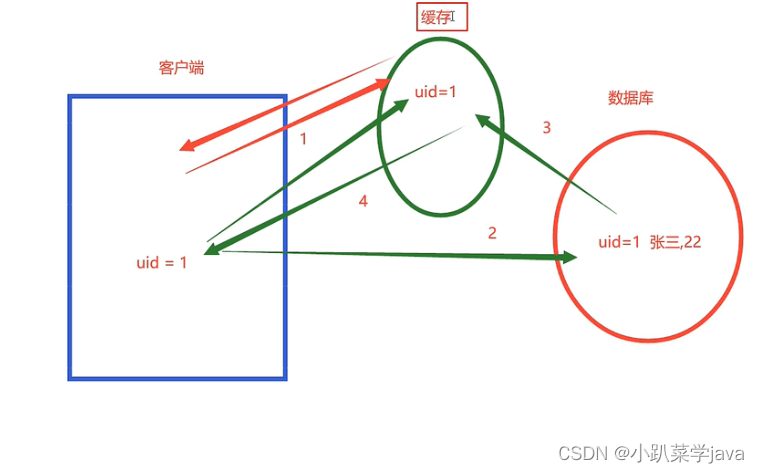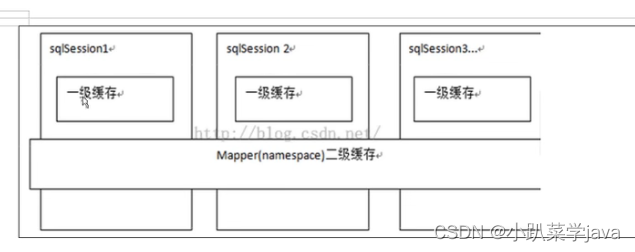目录
表的关联关系
关联关系是存在方向的
1,一对一
2,一对多
3,多对一
4,多对多
一,一对多的关联关系
创建表:
use ssm;
Create table customer(
id int primary key auto_increment,
name varchar(32),
age int
);
insert into customer values(1,'张三',22);
insert into customer values(2,'李四',23);
insert into customer values(3,'王五',24);
create table orders(
id int primary key auto_increment,
orderNumber varchar(16),
orderPrice double,
customer_id int ,
foreign key (customer_id) references customer(id)
);
insert into orders values(11,20,22.22,1);
insert into orders values(12,60,16.66,1);
insert into orders values(13,90,19.99,2);
select * from customer;
select * from orders;
创建实体类:
public class Customer {
private Integer id;
private String name;
private Integer age;
//用户订单信息
private List<Orders> ordersList;
...
}
public class Orders {
private Integer id;
private String orderNumber;
private Double orderPrice;
//因为customer_id是一个外键,本不属于order这个类的属性,所以,不需要创建该属性
...
}
创建CustomerMapper接口和xml文件
<?xml version="1.0" encoding="UTF-8" ?>
<!DOCTYPE mapper
PUBLIC "-//mybatis.org//DTD Mapper 3.0//EN"
"http://mybatis.org/dtd/mybatis-3-mapper.dtd">
<mapper namespace="com.mybatis.mapper.CustomerMapper">
<!--
//根据用户的ID查询用户的ID,和ID下的所有订单信息,返回的是Customer这个对象
Customer getById(Integer id);
实体类:
private Integer id;
private String name;
private Integer age;
//用户订单信息
private List<Orders> ordersList;
-->
<resultMap id="customerMap" type="customer">
<!--主键绑定-->
<id property="id" column="cid"></id>
<!--非主键绑定-->
<result property="name" column="name"></result>
<result property="age" column="age"></result>
<!--多出属性绑定-->
<collection property="ordersList" ofType="orders">
<!--主键绑定-->
<id property="id" column="oid"></id>
<!--非主键绑定
private Integer id;
private String orderNumber;
private Double orderPrice;
-->
<result property="orderNumber" column="orderNumber"></result>
<result property="orderPrice" column="orderPrice"></result>
</collection>
</resultMap>
<select id="getById" parameterType="int" resultMap="customerMap">
select c.id cid,name,age,o.id oid,orderNumber,orderPrice,customer_id
from customer c left join orders o on c.id = o.customer_id
where c.id = #{id}
</select>
</mapper>package com.mybatis.mapper;
import com.mybatis.pojo.Customer;
public interface CustomerMapper {
//根据用户的ID查询用户的ID,和ID下的所有订单信息,返回的是Customer这个对象
Customer getById(Integer id);
}
测试:
@Test
//一对多关联表查询
public void testGetCustomerById(){
Customer customer = customerMapper.getById(1);
System.out.println(customer);
}查询结果:

分析:

二,多对一
订单与客户是多对一的关系,站在订单查用户
package com.mybatis.mapper;
import com.mybatis.pojo.Orders;
public interface OrdersMapper {
//根据订单的编号查询订单信息及下单用户的信息
Orders getById(Integer id);
}
<!--
//根据订单的编号查询订单信息及下单用户的信息
Orders getById(Integer id);
private Integer id;
private String orderNumber;
private Double orderPrice;
private Customer customer;
-->
<resultMap id="ordersMap" type="orders">
<id property="id" column="oid"></id>
<result property="orderNumber" column="orderNumber"></result>
<result property="orderPrice" column="orderPrice"></result>
<association property="customer" javaType="customer">
<!--
private Integer id;
private String name;
private Integer age;
-->
<id property="id" column="cid"></id>
<result property="name" column="name"></result>
<result property="age" column="age"></result>
</association>
</resultMap>
<select id="getById" parameterType="int" resultMap="ordersMap">
select o.id oid,orderNumber,orderPrice,customer_id,c.id cid,name,age
from orders o inner join customer c on o.customer_id = c.id
where o.id = #{id}
</select> //多对一关联表查询
@Test
public void testGetOrdersById(){
Orders orders = ordersMapper.getById(11);
System.out.println(orders);
}
三,一对一
一个实体中包含另一个实体的对象既可通过一次查询,得到两个实体的关系

四,多对多关联关系
添加一个中间表来化简


五,事务
一组逻辑操作的最小单元
一致性,持久性,原子性,隔离性
MyBatis中的事务处理
通过transactionManager来管理事务是否是程序自己提交
<transactionManager type="JDBC"></transactionManager> sqlSession = factory.openSession();factory.openSeesion()里面如果是空或者false,表示手动提交,如果true是自动提交。
六,缓存机制
MyBatis框架提供两级缓存,一级缓存和二级缓存,默认开启一级缓存,提高查询数据访问的效率。
使用缓存访问数据库的流程:

如果数据库中发生了数据变化,会将缓存中的数据全部清空,保证数据的一致性。
缓存的作用域:
一级缓存:使用的SqlSession的作用域,同一个SqlSession共享一级缓存作用域
二级缓存:使用的mapper的缓存作用域,不同的SqlSession只要访问的同一个mapper.xml文件,则共享二级缓存作用域。

七,ORM:对象关系映射
Java中以对象关系操作数据,将数据库中的数据以对象的形式存储,在对象中的数据交换到数据库存储。叫对象关系映射。